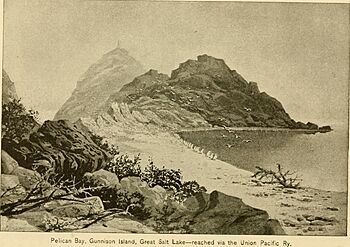Gunnison Island facts for kids

Gunnison Island, 1891
|
|
| Geography | |
|---|---|
| Location | Great Salt Lake |
| Coordinates | 41°20′20″N 112°51′29″W / 41.339°N 112.858°W |
| Area | 4.8 km2 (1.9 sq mi) |
| Length | 1 mi (2 km) |
| Width | 0.5 mi (0.8 km) |
| Administration | |
| State | Utah |
| County | Box Elder |
Gunnison Island is a special place located in the Great Salt Lake in Utah. It's about 55 kilometers (34 miles) northwest of Salt Lake City. This island is super important because it's a huge nesting spot for thousands of American white pelicans. Other birds like the California gull also make their homes here.
The entire island is protected as the Gunnison Island State Wildlife Management Area. This means people are not allowed to visit the island. This rule helps keep the nesting birds safe from being disturbed by curious visitors.
Contents
Gunnison Island: A Special Home for Birds
Gunnison Island is a vital home for many birds. Wildlife experts believe that about 10,000 American white pelicans live and nest here. This is a huge number, making up 10-20% of all American white pelicans! About 15,000 California gulls also nest on the island.
Other birds sometimes nest here too. These include the great blue heron, common raven, prairie falcon, and rock wren. The island used to be very remote, which kept predators away. This made it a perfect spot for birds that nest on the ground.

Challenges for the Birds
Recently, the water level in the Great Salt Lake has dropped a lot. This means Gunnison Island is no longer a true island. It is now connected to the mainland by a land bridge. This land bridge allows predators to reach the nesting birds, which is a big problem for them.
Another challenge for the pelicans is finding food and fresh water. The Great Salt Lake is too salty for fish to live there. So, the pelicans have to fly far to find food. They often fly about 30 kilometers (19 miles) east to the Bear River Migratory Bird Refuge. Here, the Bear River flows into the lake, making the water less salty. This allows fish to live there, which the pelicans eat.
Sometimes, the pelicans fly even farther. They might go south to Utah Lake, which is about 100 miles (160 km) away. To travel such long distances, large groups of pelicans use air currents called thermals. They ride these warm air currents high into the sky. Then, they glide down to their destination, saving energy.
History of the Island
Gunnison Island was named after John W. Gunnison. He was an American explorer and surveyor. He explored the Great Salt Lake valley in 1849.
In the mid-1890s, an artist and writer named Alfred Lambourne lived alone on the island for a year. He stayed there from November 1895 to March 1896 all by himself.
Guano Mining on the Island
In March 1896, some people came to the island. They wanted to collect and sell the large amounts of guano (bird droppings). Guano was used as fertilizer. Lambourne wrote about these guano collectors in his book, Our Inland Sea. He left the island with the first group of guano collectors in early winter 1896.
The mining activity caused problems for the birds. The pelicans temporarily left Gunnison Island as a nesting site. However, the gulls stayed even with the people around. Collecting the guano was very difficult. Also, the rain would wash the guano back into the Great Salt Lake. Because of these problems, the guano industry stopped about ten years after it began.

